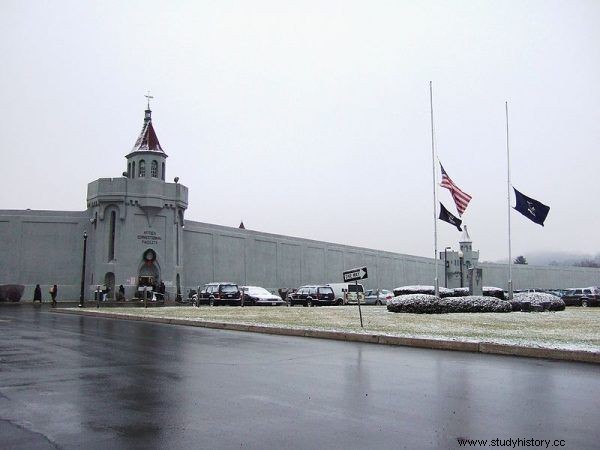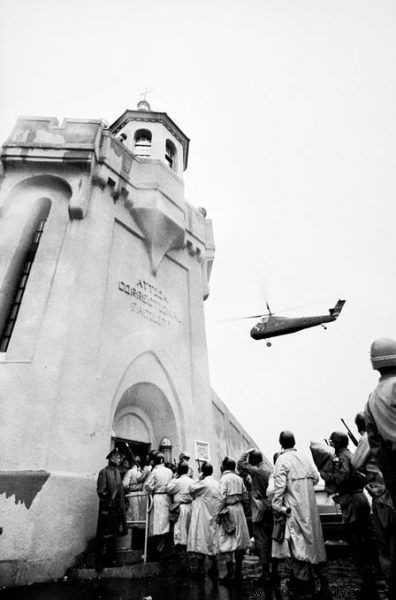On September 9, 1971, there was a tragic rebellion in the Attica prison. However, it was not a spontaneous outburst, but the effect of years of abuse. The prisoners decided to take bloody revenge ...
Williams and Sternberg were particularly indifferent to the needs of Puerto Ricans detained in Attica. None of the doctors spoke Spanish, and none of them once asked the prison managers for an interpreter. There was only one way Angel Martinez had told doctors about severe leg pain in one way:pull up the trouser legs and show the swelling. Still, they did nothing to help him. These doctors did even less for the men detained in block Z. One of the prisoners in this separate housing unit had broken bones in his hand. The pain was so excruciating that the man couldn't move his fingers. At his plea for help, Sternberg turned his back and told him to write a letter with the appropriate request to another doctor.
First attempts to protest
Doctors in Attica were so regularly indifferent to the medical needs of the inmates that in 1969 civilian workers in Block E tried to initiate some sort of action. This year, Dr. Williams, a 30-year-old inmate from block E died, and prison staff decided to convene a meeting and discuss the issue of bringing the doctor to justice. Several contingencies were taken into account, such as a picket in front of his private office, the publication in the newspaper of an article detailing the causes of the prisoner's death , writing a letter to one of the congressmen and encouraging inmates to write a similar petition to their representatives in the government. One of the debaters wanted to go a step further by taking Dr. Williams before the county attorney accusing him of medical malpractice. Ultimately, however, these plans failed, and Dr. Williams did not change his approach to the charges at all.

The article is an excerpt from the book Bloody Rebellion. The story of the uprising in the American Attica prison Editio Publishing
From time to time, the prisoners' families made attempts to intervene in order to provide their relatives with better medical care. One woman was so irritated by the lack of necessary treatment for her son in Attica that she enlisted the help of one of the leaders of FIGHT, a social organization based in Rochester. It was a clergyman who in turn wrote to the deputy commissioner at the Department of Correctional Services:"If the situation is not resolved by your people, we will have to send our own doctors to investigate [the prisoner]." Instead of familiarizing himself with the situation, the ministry representative took offense and replied laconically:"There is no legal provision that authorizes you to send doctors to examine any prisoner."
Medical experiments
While Attica prison officials were reluctant to pressure doctors to provide better care for inmates, willingly agreed to conduct medical experiments on inmates . A doctor, working at Rochester and Strong Memorial Hospitals, conducted a "study of the immune system's response to viral infections" at the facility. The physician knew that he would need volunteers for his research, and as finding a steady pool of volunteers was not easy, he was very grateful for permission to use Attica's prisoners for this purpose.
Because in return for undergoing the experiment, inmates in Attica received much needed money, many volunteered for virus testing. Although the doctor made sure that each of the inmates signed an appropriate consent, he later admitted that their knowledge on this subject could raise doubts.
Conditional release?
The widespread disrespect for the health of inmates in Attica undoubtedly undermined their morale, but other matters related to the modus operandi of the state penitentiary system, such as parole laws, had a similar impact. Allowing prisoners to leave prematurely was, of course, the dream of every prisoner, but the way it could be earned was shrouded in mystery. Once a month, a committee would come to Attica to decide on early release, but it was never clear why some prisoners qualified for early release and others did not. As one of the inmates noted:"It's very arbitrary."
But even for those who somehow managed to get a chance of early release, the joy was usually short-lived, because they couldn't really leave Attica until they had some work done outside the factory walls. With this thought, the inmates were handed out a long-obsolete telephone directory so that they could search for information about companies with whom they could contact regarding possible employment. Since many of the inmates could barely write and all had to pay for paper and stamps, finding a job in this way was extremely difficult.

Years of irregularities and abuses have brought prisoners to a last resort.
There have been known cases of inmates who saved money and wrote two or three hundred letters but were still in prison long after the parole was granted, before receiving any response. Parole procedures were so fickle that even the wardens noticed their handicap. It was much more difficult for them to deal with inmates who felt repeatedly mocked and deprived of the time they had gained.
Costs, costs, costs
The continuous cuts in costs by the administration also caused unnecessary tensions in prison life. Some guards felt that instead of letting prisoners sit idle, more opportunities for professional development and study should be provided, but DOCS has always been hiding behind serious budget shortcomings. Due to the inadequate budget, the administrators also saved too much on food for the inmates. One resentment guard put it this way:"It would take an extra dollar for nutrition to solve many of our problems."
According to state officials, however, the money was barely enough even for basic needs. Only 6.19% of Attica's operating budget was for food, 0.69% for medical resources, 1.6% for professional development and education, and 1.65% for clothing. was that due to the highly discriminatory way in which the governors managed the institution, some of the inmates faced more adversities than others. While every Attica prisoner had to work and combine in various ways to ensure that basic livelihoods were replenished, African Americans and Puerto Ricans were forced to manipulate much more because their work was generally less well paid.
Although only 37% of the inmates were white, they were the ones who filled 74% of the positions in the Attiki power station, 67% of the coveted office jobs and 62% of the posts in the canteen for employees of the facility. By comparison, 76% of poorly paid jobs in a formidable metal workshop and 80% of cumbersome construction work were carried out by African Americans and Puerto Ricans. Even if white got one of the lesser jobs, he was often better paid to get started.
Racial censorship
Occasionally, racial discrimination acted in a way that was particularly against the personal welfare of Attica's detainees. For example, while they were all theoretically subject to censorship of their correspondence, in practice black and Puerto Rican prisoners suffered most from it. Every month, the administrative commission selected publications for censorship, but the list of banned titles was overwhelmingly made up of items reported by inmates of a skin color other than white.
Whether it was black community newspapers like Amsterdam News or Buffalo Challenger, or religious publications like The Messenger or Muhammad Speaks, books of color ordered by prisoners of color rarely passed through the mailroom. For reasons that never needed to be justified, the plant administrators found the material too dangerous. As one DOCS lawyer put it, the rules for "black Muslims" were "essentially the same as those for other religious sects, except that there was a need to be even more cautious and vigilant within this group." Furthermore, any letters in Spanish or publications in that language did not even have to be considered incitement to have them confiscated. If it wasn't written in English, it was put in the trash.
Puerto Rican and African-American prisoners were also subject to much stricter restrictions on family visits. There were 26.6% of Puerto Rican and 20.4% black Attica inmates in informal relationships, but the facility's rules made it clear that partners and children from such relationships were not allowed to visit inmates. Even letters sent by partners were confiscated. In one such letter, written by an inmate to the mother of his child, he explains how she could potentially contact him while in Attica.
Honey, I know you will be surprised by this letter, so read it carefully several times. I smuggled him in (...). When you write, don't make a mistake and don't put your name on it. " In case her letters did not reach him after all, he continued:“I listen to WMYR Rochester radio, from 6.30 pm to 7.30 pm after supper. You can call and ask the tutor for something. I'll listen to your voice through headphones. Ask for the song "I'm so afraid of losing you" and say hello to me. I will start listening as soon as this letter is sent. ”

The helicopter is heading towards Courtyard D above the heads of the New York Police forces entering the prison. (Courtesy of LIFE Picture Collection / Getty Images)
The racial discrimination in Attica was so blatant that even white prisoners had no hesitation in affirming that black and Puerto Ricans were enforced differently by the guards. While this kind of discrimination contributed to an escalation of tensions in Attica, a similar effect was exerted by the worsening overcrowding problem which exacerbated the stress among both prisoners and guards.
Despite the increasing overpopulation in Attica in the late 1960s, instead of employing more guards, the management of the facility decided to hand over the responsibility of the existing prison service to guarding even more inmates. After moving to Attica in 1971, ranger John Stockholm found it hard to believe that he was found to be responsible for approximately 60-70 inmates at once (...). Sometimes we even took 120 prisoners for breakfast. ”
The fact that the prison administration expected one guard to control two or even three companies of men on the way to the canteen, to work and to the yard, and to do it several times a day with only a police truncheon at his side, put a great deal of pressure on prison officers and aroused anxiety also among inmates.
The truth was that, in these circumstances, the only way to ensure that the prison functioned smoothly was that inmates usually complied with the rules and did what the guards responsible for them did. As the number of penitentiaries grew, however, order and peace became more and more difficult.
Awareness is growing
The profile of a typical prisoner going to Attica has also changed significantly. Many of the inmates were young, politically aware and determined to speak out about the injustices in the facility. They were black and brown young people who were greatly influenced by the human rights battles at the time and the work of Malcolm X, Mao and Che Guevara.
These people made it clear that they were more likely to defend their rights and less likely than Attica veterans to submit to mistreatment. This new type of prisoner raised concerns among the guards, and their fear and suspicion of the more eloquent inmates added to the tensions within the facility.

The article is an excerpt from the book Bloody Rebellion. The story of the uprising in the American Attica prison Editio Publishing
On the assumption that they should treat these younger, more militant prisoners harshly, the guards repeatedly resorted to intimidation, insults and the enforcement of frivolous, onerous laws, which practically guaranteed an aggressive response from the prisoner. Increased "manifestations of solidarity and rebelliousness of inmates" as a result aroused even greater aggression among the guards. Although the majority of prison wardens knew deeply that their own safety depends on ensuring that prisoners - as one of the guards put it - "have respect and the feeling that all legitimate complaints (...) will be considered", many of of them were too bitter, angry, and even scared to follow these principles.
The article is an excerpt from the book Bloody Rebellion. The story of the uprising in the American Attica prison Editio
